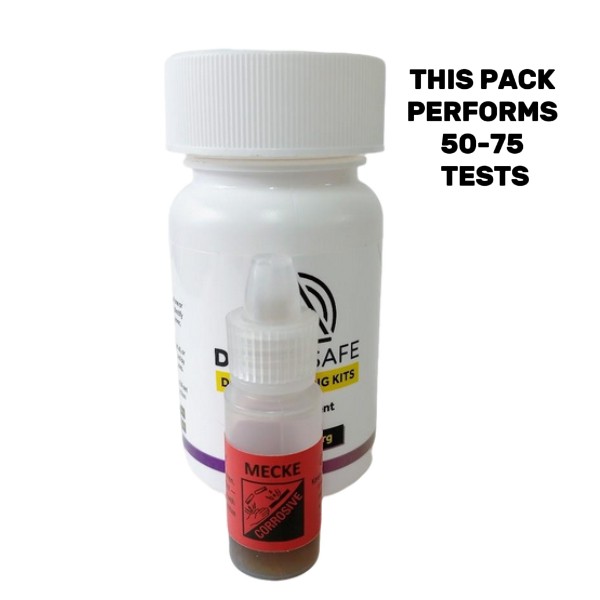Please Note:
We will be closed on Fri 12 December (open again Mon 15 Dec)
Last day for orders in 2025 - Tue 23 Dec - View our Xmas hours
Information
What Are Reagents?
Reagents are chemicals that turn certain colours when they come into contact with certain drugs. Reagents cannot detect every drug, nor can they tell you how pure or potent your drugs are. Even if you get the expected colour reactions for the drug you want, there could still be one or more other drugs present. This is because:
- Not all drugs change colour with reagents.
- Darker colours may overshadow lighter colours.
- A very tiny quantity of a drug may not produce a visible colour change.
Despite these limitations, reagent testing is useful for determining whether your sample definitely does not contain the drug you want.
Reagents Can:
- Detect the presence of certain drugs
- Give you information about whether a drug is suspicious
- Inform your decision about whether or not to consume a drug
- Tell you how potent your drugs are
- Tell you if your drugs are pure
- Confirm exactly what is in your drugs
How To Use Reagents:
- Place a tiny amount of your drug onto a white, ceramic plate. Make it about the size of a pinhead. We will refer to this as the “sample” of your drug.
- For pressed pills, use a sharp knife to scrape the powder off the side.
- For blotter paper, cut off a tiny piece of the corner.
- For liquid drugs, place one drop onto the plate.
- Carefully place one drop of reagent onto the sample.
- Do not let the bottle touch the sample or you will contaminate the entire bottle of reagent. Do not put the cap of the bottle on any surface or on the wrong bottle or contamination may occur. Place the drop from the bottle onto your sample, hold the cap in your other hand, then replace the cap immediately.
- If you are using a 2-bottle reagent such as Simons, Folin, or Morris, place one drop from bottle A and then one drop from bottle B onto the same sample.
- Observe the colour change and compare with the enclosed colour chart.
- Most reagents will change colour within 20 seconds and are accurate for about 45 - 60 seconds.
- Ehrlich’s reagent can take up to 20 minutes to react and the reaction is accurate for around an hour.
- Morris reagent is the only reagent that needs to be stirred. Use a toothpick or the sharp point of a knife. The final colour will appear after stirring for a full 30 seconds & will remain accurate for around 5 minutes.
- Repeat.
- Most drugs need to be tested with more than one reagent.
- When using multiple reagents:
- Put the cap back on the first reagent.
- Repeat the process using a new sample for each reagent.
- Clean up.
- Use baking soda to neutralise the chemicals, then wash the plate with soap and water.
BE AWARE:
There are over 25,000 drugs on the market, and there are many factors that can influence a reagent reaction.
When you’re reading the colour chart, it’s very important to remember that you’re looking for red flags, not green lights. You should see whether the colour reactions you’re getting are “as expected” for a given drug.
If any reactions are unusual, the reaction is “not as expected.” It’s impossible to know which of the six factors listed below have caused an unexpected reaction without sending the sample to a lab.
Things that can cause an unexpected reaction:
- Leftover precursors (ingredients used to make a drug)
- Impurities from the manufacturing process
- Adulterants (active drugs cut in, like meth in MDMA pills)
- Bulking agents (inactive drugs cut in, like supplements)
- Mixtures (multiple things in the sample)
- Analogs (drugs that are very chemically similar to a more popular substance, and might react almost exactly the same despite having different dosages or effects)
Storage & Handling Instructions:
- Store reagents in their original containers as they include child safety lids and keep out light.
- Keep reagents out of heat and sunlight to prolong shelf life. A freezer is ideal (thaw to room temperature before using) but a fridge works too.
- Most reagents typically last 1-2 years in the fridge, longer in the freezer.
- Dispose of reagents at a hazardous waste facility.
- Mandelin reagent starts out light orange in colour and turns cloudy yellow after 3-4 weeks. This is okay. Make sure to shake the bottle before each use.
- Marquis and Mecke reagents begin as clear liquids and gradually darken over time. This is okay. Make sure to shake the bottle before each use.
- Other reagents gradually darken over time. They are only expired when the liquid in the bottle becomes so dark that you can no longer see the colour reaction.
- Use a test drop on sugar to to make sure the reactions are clear.
Common Mistakes:
- Using a dirty testing surface
- Using a non-white testing surface
- Using two-part reagents on two different samples. Two-part reagents should be used on the same sample. One sample with a drop from part A, then a drop from Part B.
- Putting the reagent cap on the wrong bottle, or on a dirty surface. This may contaminate the whole bottle.
- Using an expired reagent. If you can’t clearly see the reaction when using a test drop on sugar, or if the reagent liquid is very dark, the reaction may not be readable or accurate.
Product Enquiry
Contact Details
Request More Information
Details of the product above will be automatically included with your enquiry.
Associated Items
View your shopping basket or Browse other items in Drug Identification Kits.
| Top |


